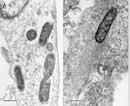Removing genes, another way to evolve

Evolution
has always made sense of progress for us. Therefore, we understand evolution as an increase in the complexity of organisms, such as obtaining new genes. But evolution does not always follow that path: simplicity can also be progress. They have seen this at least in the case of Rickettsia prowazekii.
In short, for a small bacterium like R. prowazekii, maintaining an unnecessary gene is energetically very expensive. Therefore, when a bacterium has to adapt to a new ecological corner, one way to improve the effectiveness of the infection can be the removal of unnecessary genes.
This bacteria has insects as a natural host, through which you can pass to man and other animals. Scientists have seen that some genes in the bacteria only function partially and have considered that they were functional in the past, although a process of degradation has subsequently occurred.
To find out if it has been a product of degradation, Didier Raoult and his co-workers at the Marseille School of Medicine have compared the bacteria to their similar Rickettsia conorii. Both species come from the same ancestor, although 40-80 million years ago they separated from each other. Comparing their genetic sequences, they have observed significant differences. On the one hand, R. prowazekii has a lower genome of base pairs, so it is smaller, but it also has fewer genes than those corresponding to this lower genome: R. Conori has 1374 functional genes and R. prowazekii only 834. It seems to be the result of a process of loss, as R. prowazekii has found traces of 229 genes that R. conorii has.
However, it seems that gene loss is a very gradual process, as bacteria have seen various intermediate structures of this loss. This discovery will help to understand evolution in another way and to see how degradation of genes occurs, which can in turn be a way to cause functional changes in genes.
Buletina
Bidali zure helbide elektronikoa eta jaso asteroko buletina zure sarrera-ontzian











